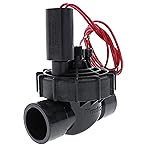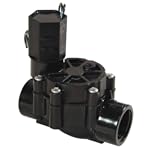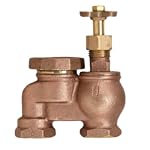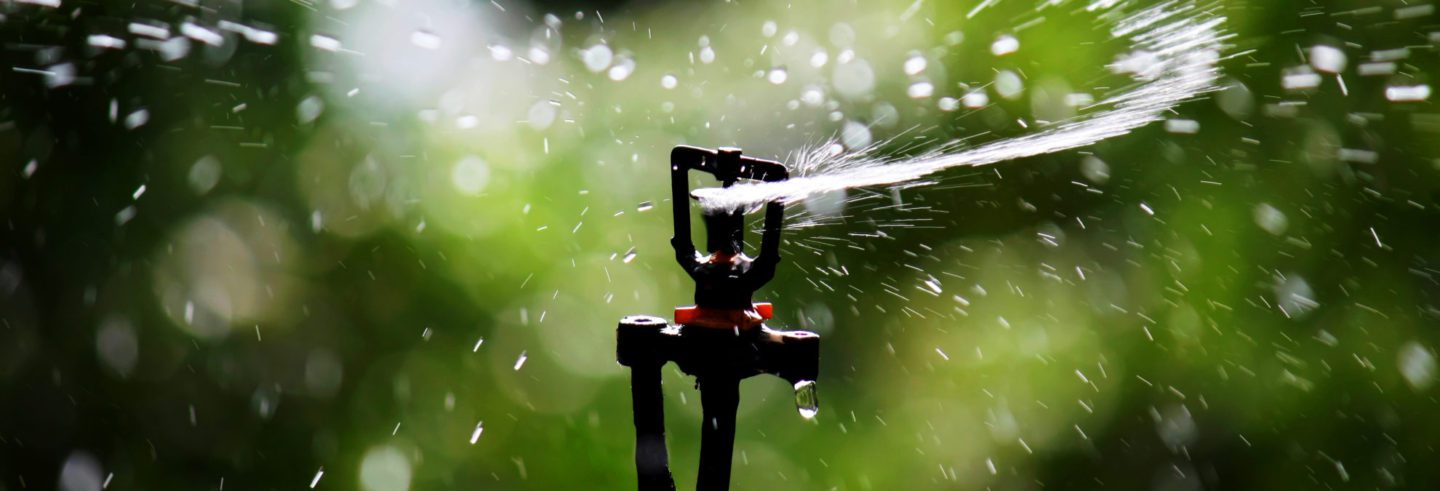Consumer Mentor is reader-supported. We may earn commission on sales through our links at no extra cost to you.
When it comes to maintaining a beautiful and healthy lawn, having the right sprinkler system is key. A good sprinkler valve is a crucial component of any irrigation system as it controls the flow and distribution of water to your lawn. However, selecting the right sprinkler valves for your yard/garden can seem complicated. They come in seemingly endless varieties, each offering a different combination of features that tailor to a specific environment. Making the wrong choice can result in a mist that simply floats away or even dirty water re-entering your drinking supply.
However, you don’t have to be a specialist to make the right decision. You simply need to know your irrigation system’s basic features and what part of the country you live in. With this information, we’ll inform you about what features you require and recommend the ideal sprinkler valves for your landscape.
Benefits of Sprinkler Valves
Before we dive into the different types of sprinkler valves and how they work, it’s important to understand the benefits of using one in your irrigation system. Sprinkler valves allow you to control the water flow and distribution in your lawn, ensuring that the right amount of water is delivered to the right areas. This helps to prevent overwatering and reduces water waste. Moreover, sprinkler valves can help to automate your irrigation system, saving you time and effort.
How a sprinkler valve works
A sprinkler valve is a type of globe valve.
Its basic action is to take in water through an inlet, store and repressurize it in a chamber, then release it through an outlet. For manual sprinkler valves, this simple explanation of the mechanism is essentially complete. Manual sprinkler valves regulate flow control by rotating a handwheel on top of the chamber. They may also include a bleeder, which you can turn with a screwdriver to release trapped debris. This process is called weeping and should be performed when you notice leaking from the valve body.
Note: Only partially unscrew the bleeder or it may fly off. Also, make sure to screw it back on tightly to prevent leaking.
Most modern sprinkler systems use a different type of valve called a solenoid valve. These valves offer a range of additional features and customizations for more advanced irrigation.
Here is a great video from Rain Bird that effectively communicates exactly how solenoid valves work:
As described in the video, solenoid valves can be connected to a programmable controller, allowing you to customize and pre-set your sprinkler schedule. We’ll discuss more of the advantages and disadvantages of these two types of sprinkler valve in the next section.
Types and features of sprinkler valves
There are eight important features of sprinkler valves, each specialized for a different feature of an irrigation design or environment. We will discuss each feature and help you decide if it is required for your sprinkler system.
Inline vs anti-siphon valves
The difference between these two types pertains to back-blow. Inline valves have no back-blow prevention, whereas anti-siphon valves have a built-in feature to prevent back-blow. An anti-siphon mechanism consists of an open port, a poppet (a disk that covers the port), and a spring that holds the poppet. When the water is off, the spring holds the poppet away from the port, but when water is flowing the spring pushes the poppet to cover the port.
Prevention of back-blow into your drinking water is essential for sanitary reasons, but anti-siphon valves also have other added benefits. Anti-siphon devices remove residual water remaining in the bonnet chamber, preventing ice damage during cold winters. They also help to equalize the chamber pressure in each sprinkler head.
Inline valves are cheaper, so your decision comes down to whether the design of your irrigation system can accommodate inline valves.
Most professional installations use inline valves. Such installations are usually set up as follows:
- An irrigation pipeline is drawn from your home’s main water line.
- The irrigation line is fitted with an upstream back-blow prevention device.
- A single mainline runs around the lawn, fitting an inline valve in each sprinkler zone. These zones are spaced evenly to distribute pressure.
- The mainline connects back just before the back-blow prevention device.
Some irrigation systems have their inline valves housed in a manifold at the center of the lawn, with piping extending out to sprinkler zones. This system may also use inline valves, but the design uses more piping and will be more expensive than the previously described design.
We recommend anti-siphon valves for most DIY installs, as equalized pressure at each output is essential for a functional irrigation system. Additionally, if you do not have back-blow prevention, anti-siphons are a must.
Plastic vs. brass valves
Plastic has become the industry standard for valves as it can withstand high pressures while being highly cost-efficient. Plastic valves are also more amenable to repairs, whereas brass valves must be fully replaced if damaged. The advantage of brass is that it is more resistant to morphing or cracking under extreme temperatures. Therefore, if you live in such climates, brass may be a safer bet, though you may have to compromise on functionality.
Electric vs. manual valves
As previously described in the “how does a sprinkler valve work” section, manual valves must be turned on by hand and have limited functionality compared with their electric counterparts. Electric valves, or solenoid valves, allow you to pre-program your sprinkler schedule, giving you more control. If your sprinkler system has multiple zones, we highly recommend using solenoid valves programmed by a controller.
Here are our picks for the best sprinkler controller systems:
Low-end: Rain Bird SST600IN


- Can control up to 6 zones independently
- Surge protection
Mid-range: Rain Bird SST1200OUT


- Can control up to 12 zones independently
- Super surge protection
- Water protective sealed case
- Large, intuitive display and control panel
High-end: Rachio Smart Sprinkler Controller


- Can control from 4-16 zones independently
- Remote control via smartphone
- Adjusts based on weather
- Voice control with smart home
- Quick, tool-free installation
Different sizes of connections
The inlet and outlets of sprinkler valves have diameters typically varying between 3/4″ – 2″. The valve’s diameter should not necessarily match the pipe’s diameter. The valve size determines the water pressure inside the bonnet chamber. The mechanism of automatic solenoid valves uses water pressure to position the diaphragm. When the solenoid signals the plunger to plug water flow into the solenoid dump port, if the pressure inside the bonnet chamber is too low, the diaphragm may not close.
If the flow rate of your system is above 5 GPM, you may safely use the following rule to judge the correct diameter for your sprinkler valve (if not consult the manual of any solenoid valve you wish to buy for guidance). Make your valve size one size below your pipe size. You can fit valve sizes that don’t match your pipe size with bushings.
For a manual valve without an anti-siphon, sprinkler valve diameter is not usually important. If you have a high-pressure system and are using an anti-siphon, over-pressurizing the valve may cause damage to the anti-siphon mechanism. In this case, fitting a valve larger than your pipe size will solve this problem.
Connections on inlets and outlets
There are four main types of connection.
1. Slip connections
Slip connections are popular as they are easy to fit. Simply glue the valve onto the piping, and you are ready to go. This connection offers excellent leak prevention and is popular in professional fittings.
2. Male/female threading connections
Male/female threading connections provide less leak protection than slip connections but instead are easier to install and repair. Unlike slip connections, male/female threaded connections can be taken apart without damage to the inlet. This connection type can be particularly advantageous if you anticipate any restructuring of your irrigation system.
3. Barb connections
For areas of the country that use PolyPipe, barb connections are required.
4. Angle valve connections
Angle valves are a special type of valve designed for cold-climates with deep soil frost penetration. In such environments, piping is buried deeper into the ground. Therefore, vertical piping channels are needed to draw from the mainline up toward the sprinkler valve. This means that the inlet lies perpendicular to the outlet.
Our angle valve recommendation is the Irritrol 2600T Angle Valve. Despite being made from plastic, this valve has good temperature resistance and even has threaded connections for easy replacement.
If you are not using an electric sprinkler system, the CHAMPION IRRIGATION PD 200RS-075Y Brass Angle Valve is ideal as it has greater temperature resistance.
Jar-top vs. bolted down
Jar-top valves deviate from the typical bolted down variety in that the top of the valve can be removed. This feature allows for easy repair of a broken valve’s internal components, without having to replace the entire valve. Jar-tops are particularly practical if you are using slip connections, as it makes repair-work much easier. Bolted down valves have the advantage of being slightly more durable and leak resistant, but all things considered, jar-tops are the better option.
Flow control vs no flow control
Flow control is highly recommended for any sprinkler system that uses different heads for different zones. Head attachments require different water pressures for optimal performance. For example, spray heads perform optimally at around 30 PSI, whereas rotary heads perform best at around 50 PSI. If spray heads are over-pressurized, the spray becomes more like a mist that floats away, causing inefficient water distribution.
If your irrigation system has only a few zones that connect directly from the drinking supply, flow control on each valve may be more efficient than a master flow control valve. Such a system should also have anti-siphon devices on each valve.
Drawing from clean or dirty water
Most irrigation systems draw water directly from their home’s mainline. However, some will draw from a nearby pond or stream. In this case, you will require a valve with a self-cleaning filter. Weathermatic valves are a great choice for this purpose.
Factors to Consider When Choosing a Sprinkler Valve
When choosing a sprinkler valve, there are several factors to consider:
- Water pressure and flow rate – Ensure that the valve you choose can handle the water pressure and flow rate of your irrigation system.
- Valve size – The valve size should correspond to the size of the pipe in your irrigation system.
- Durability – Choose a valve made from high-quality materials that can withstand exposure to the elements.
- Valve type – Consider the type of valve that is best suited for your irrigation system.
Top sprinkler valves for common set-ups
Here we will detail the most common irrigation system set-ups and review the best sprinkler valves for each system.
An inline electric system with serial mainline
This is the most common professional installation and is ideal for landscapes with many zones. This setup includes a master control valve, upstream anti-siphon device, a single mainline running through each zone, and an inline solenoid sprinkler valve at each zone.
An emergency shut-off valve is essential for preventing damage to your system caused by incorrect set-up or faulty parts. It is also useful while working on your irrigation system. We recommend using a ball-valve such as the Hayward SP0723. These valves are very durable and the last thing you want in an emergency is to find a broken master valve.
Sprinkler valves in this set up should ideally have the following attributes:
- Inline flow
- Solenoid/electric
- Flow control
If you use slip connections, a jar-top valve will be necessary for easier repair jobs. Other connection types may use bolt-down valves, though jar-top is still preferred.
Here are our recommendations for different connection types:
Slip connection: Hunter 101JT-GS


- 1-inch connection
- Heavy duty – long life
- Built-in flow control
- Jar-top
- Internal manual bleed
- Lifetime warranty
Threaded connection: Rain Bird CP100


- 1-inch connection
- Female threaded
- Built-in flow control
- Manual bleeding screw
- Reverse flow design for reduced stress on diaphragm components
- Energy efficient
Barb connection: Irritrol 2400T-B


- 1 inch connection
- Threaded jar-top bonnet
- Internal and external bleeder
- Male x barb connection
- Stainless-steel metering system
Angle valve: Irritrol 2600T


- 1-inch connection
- Threaded jar-top bonnet
- Internal and external bleeder
- Female x female connection
- Stainless-steel metering system
An inline electric system with a central manifold
As with the previously described set-up, a central manifold design has an upstream back-blow prevention device, so anti-siphons are not required. A manifold for containing valves is usually located at the center of the lawn/garden with piping extending from each valve to a single zone.
The same sprinkler valves as described in the “Inline electric system with serial mainline” system may be used for this set-up. You may also choose to use a pre-built manifold system for fast installation and optimal pressure distribution.
Orbit 57253


- Preassembled with either 3 or 2 valves
- Compatible with 1 or 3/4 inch systems
- Available with either threaded or barb connections
- Fast install
- Jar-top valves
Rainbird 100DVF


- Either 4 or 6 valves
- Self-cleaning filter
- External bleeder
- Energy efficient
- Internal and external bleeder
- Available with slip or threaded connections
- Not recommended for 2 wire control systems
No upstream anti-siphon system
If your system gets its water supply directly from the house without an upstream anti-siphon device, you will require anti-siphons on each valve. Systems like this often contain fewer sprinkler zones and are designed for easy set-up and flexible zone placement. For smaller systems like this, upgrading to solenoids may not be necessary.
Brass Valve: Orbit 51016


- 3/4 inch connection
- Manual brass valve
- Flow control
Electric valve: Rain Bird DASASVF100


- 1-inch connection
- Female x female threaded connections
- Flow control
- Bleeder screw
- Heavy duty professional grade
- Energy efficient
Conclusion
Buying from trusted brands such as Hunter, Rain Bird, Orbit, and Irritrol is the best bet for ensuring quality valves that won’t suddenly break on you during a cold winter. Valves are inexpensive compared with the cost of having them fixed, so it is worthwhile investing in a tough and durable model. We hope this guide has given you a good overview of what features are available for sprinkler valves. This information should be sufficient to help you choose the best sprinkler valve your irrigation system. If you are still unsure about which valve is suitable for your system, feel free to leave a comment below and we’ll gladly answer any queries.

I have an indexing system now that I am going to convert to a zone controlled system. I have four zones. I want to get valves that are set it and forget it. The Hunter 101JT-GS is the only one that has a note of heavy duty, long life. Is this the best valve for my situation?
South Florida, U.S.A.
Thanks for helping me understand that we just have to know the basic features of the system to make the right decision. I will share this tip with my sister to help her out. They just need one in the new house that they moved into since it has a huge lawn which she never tried caring for before. This is because she always lived in a condo unit back then.
can anyone remember the guy valve, a zone system that works entirely on
water pressure except for initial pressure solenoid which is timer controlled.